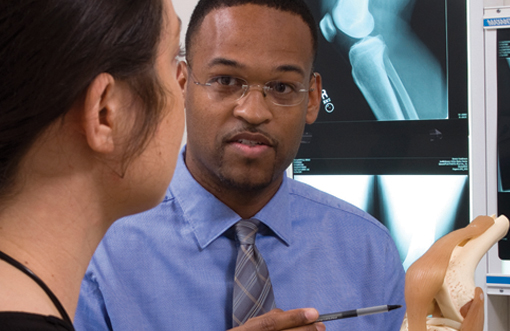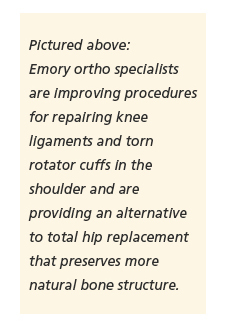Patient care: Pioneering innovations

Each year, Emory medical faculty are responsible for approximately 3.6 million patient visits, providing care that covers the full spectrum of medicine, from fetal to geriatric, from preventive and primary care to the most specialized care in the region. They practice in both public and private facilities, including those within Emory Healthcare, the largest, most comprehensive clinical system in Georgia.
In this section:
Refinements in heart care | Treatment advances in cancer
Inside the brain | New facilities, present and planned

Refinements in heart care
Valve replacement—Emory interventional cardiologists are moving forward with clinical trials of nonsurgical aortic valve replacement in high-risk patients with aortic stenosis. They place the valve via catheter through a small incision in the groin or chest wall. Thus far, they have done 24 such procedures, with a success rate of 100%. The procedure is easier on the patient, offers quicker recovery time, and may extend the lives of people too ill or frail to endure open-heart surgery. The hospital is one of five nationwide and the first in the Southeast to participate in this trial.
Improving electrophysiology—In other heart work, Emory cardiologists are using a new robotic catheter system, called Sensei, to improve treatment of arrhythmia. The system improves precision and stability for the electrophysiologist in guiding a catheter to destroy heart cells whose electrical misfires stimulate the abnormal heart rhythm. The system is remote, minimizing physician exposure to radiation and allowing the physician to sit during the procedure, which helps reduce fatigue during long or multiple cases.
Repairing tissue—Colleagues in cardiology and hematology/oncology are collaborating in clinical trials in which patients receive varying doses of bone marrow stem cells that have shown promise in improving circulation around damaged heart muscle. Their work focuses on a signaling molecule released by damaged tissue to help guide stem cells to sites where tissue repair is needed.
Treatment advances in cancer
Better breast imaging—In an Emory clinical trial of more than 1,000 patients at elevated risk for breast cancer, stereoscopic digital mammography reduced false-positive findings by 49% and missed lesions by 40%, compared with standard digital mammography. Stereo mammography, which allows radiologists to see the internal structure of the breast in three dimensions, may change standard mammography. Increasing its use would require only simple upgrades to existing digital mammography equipment and software, and such images take no more time to read than standard mammograms.
Taking better aim—This year Emory's Winship Cancer Institute implemented several new technologies to improve radiation therapy. Winship became the first cancer facility in Georgia, for example, to use a new localization system allowing radiation oncologists to detect and monitor slight movement of prostate tumors and thereby deliver higher doses of radiation while minimizing or avoiding irradiation of adjacent healthy tissue.
Winship also was the beta test site for a new state-of-the-art system for radiation of tumors deep within the brain. The system can be used also for primary lung cancers, liver and pancreatic cancers, and bone metastases.
Inside the brain
Depression—Emory clinicians were pioneers in use of deep brain stimulation (DBS) in Parkinson's and other movement disorders and now are using DBS in patients whose depression has been unresponsive to other therapies. They helped pinpoint a location in the brain called area 25 that regulates depressed mood and found that this region responds to DBS, opening a promising new line of treatment for depression.
Alzheimer's—Working with colleagues at Georgia Tech, Emory clinicians developed a new helmet device that can quickly and cheaply detect the impaired memory and reaction time associated with the earliest stages of Alzheimer's disease. The device, called "Detect," includes an LCD display in a visor with an onboard dedicated computer and noise-reduction headphones. The test takes only 10 minutes and costs so little and is so simple to administer that it could be part of a routine medical check-up in virtually any setting.
Preliminary studies at Emory's Wesley Woods Center have shown that the test is similar in accuracy to the "gold standard" pen and paper test that requires 90 minutes and must be given by a trained technician in a quiet environment. The device is expected to become available commercially soon. Another version is being tested to detect mild concussions during high-impact sports or on a battlefield.
Stroke—Time is tissue. After stroke, time lost is tissue lost, which is why quick intervention is so imperative. Recently, Emory became one of the nation’s first "neuro rescue" training and certification facilities, hosting physicians from around the country for an interactive, simulation-based stroke intervention course, launched by the Society for Cardiovascular Angiography and Interventions. Using hands-on simulation, cardiologists were able to practice removing a clot from the brain, using a newly FDA-approved catheter-based clot-retrieval device.
New facilities, present and planned
Emory University Orthopaedics & Spine Hospital, an extension of Emory's acute care hospital on Clifton Road, opened in suburban Atlanta in fall 2008. The six-story facility, with 208,000 square feet of space including a medical office building, concentrates orthopaedics and spine surgery at one location to facilitate better recovery times, safety, and patient satisfaction. The hospital joins Emory Healthcare's other hospitals and clinic as part of the largest and most comprehensive health care system in Georgia. Construction of a new 395,000-square-foot Emory Clinic facility, adjacent to current clinic buildings on the Emory campus, is slated to begin in 2009. Construction of a new 250-bed hospital facility, including 100 replacement beds for the current Emory University Hospital, is slated to begin in 2010. Plans also call for eventual new clinic and hospital space at Emory's midtown campus as well as new research space on both sites that will facilitate collaboration between clinicians and scientists.
Planning for all of these facilities involves input from a diverse range of stakeholders—from clinicians, researchers, educators, administrators, and staff to patients and their families.

